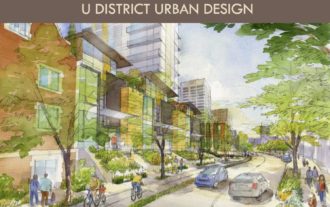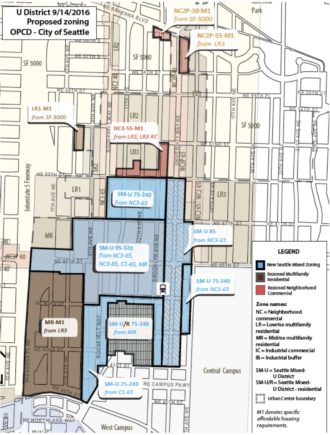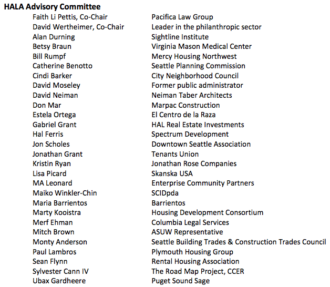
More people want to live in Seattle than there are homes. The number of people moving to our magnificent city is growing faster than all those cranes you see in the skyline can build.
When homes are put out to bid at market values, people who have more money get them. Those who don’t have as much money get priced out. Communities are broken up. Many families that can least afford the many costs of driving end up living in car-dependent suburbs. And since affordable rent is one of society’s most important safety nets, a growing number of people end up homeless when rents rise.
The cold reality of Seattle’s market-rate housing is shameful, and there is nowhere close to enough subsidized housing to meet the need. Our city is doing so many other things right, but it’s so far failed to respond to people’s most basic need: A home.
The good news is that there are also a lot of engaged people who want to respond to this affordability emergency with bold action. And the Seattle economy has plenty of cash flow to solve this problem, but only if we work as a city to prioritize affordability.
The city’s desire to take bold action will be tested this autumn as the City Council votes on a revamped U District urban design plan. You can weigh in on the plans starting at 5:30 p.m. tonight (Wednesday) at Hotel Deca (45th and Brooklyn). Presentation starts at 6, public hearing starts at 6:15.

Right now, most residential development cash in Seattle goes into luxury condos and apartments or new giant single-family homes. And this is due primarily to Seattle’s development rules, which essentially require new development to be unaffordable.
Severe limits on the areas of the city that can build denser styles of housing put a premium on that land. Requirements for building car parking dramatically increase the cost of building a new unit, decrease the number of units that can fit in a building and decrease the amount of retail space available.
After years of planning work, the City Council is set this autumn to make a major decision about the the University District. Already one of the bikiest areas in the city, the way people get around the U District will change much more when light rail arrives on Brooklyn Ave in four years. It’s about time the city put plans in place to take advantage of this major new transportation connection and build on existing walking and biking trips.
Remember, there are two ways to increase the number of homes with safe and convenient biking access: 1) Make more communities bikeable and 2) build more homes in our communities that are already bikeable. And while biking is not exactly the end goal of these changes, biking will help make it work by giving people an affordable, easy and healthy way to get around a busier neighborhood.
 The plan includes many elements from Mayor Ed Murray’s 2015 Housing Affordability and Livability Agenda (“HALA”), a set of affordability ideas created through hard work and compromise by a variety of stakeholders including everyone from developers, major downtown institutions and hospitals, community organizations and urban planners. You can see this list to the right.
The plan includes many elements from Mayor Ed Murray’s 2015 Housing Affordability and Livability Agenda (“HALA”), a set of affordability ideas created through hard work and compromise by a variety of stakeholders including everyone from developers, major downtown institutions and hospitals, community organizations and urban planners. You can see this list to the right.
And though the U District urban design upgrades have been reduced through community process and compromise, they would be an early test of some of the promising ideas to emerge from HALA. Developers could build taller buildings, for example, but only if a certain percentage of units and commercial spaces are rented below market rate (referred to as “mandatory housing affordability”).
Of course, the U District plan is not nearly enough to address the city’s housing problems, but it’s a start. HALA is also just a start, and it may not be bold enough to fully get a handle on the problem.
I understand that people do not like change. And not all changes will be sunshine and rainbows like the watercolor image at the top of this post suggests. It’s hard to see beloved spaces get redeveloped. But as we have seen, that is going to happen whether the city changes the rules or not. The city has the power to set the development rules in a way that encourages our goals.
We need more homes, more unique small businesses and lower cost barriers for both. More than ever, we need to be a city that welcomes everyone, regardless of who they are, how they worship, how much money they make or what their immigration status is. We need to dramatically reduce our greenhouse gas emissions, most of which come from driving and energy-inefficient homes. And we need healthier communities where people can access healthy food and complete most or all of their daily errands by walking, biking and transit.
Below is a video about all the work that went into this new U District vision. Let’s pass it, then keep moving forward full steam with bold action for the rest of the city, too.








Comments
8 responses to “Seattle needs more homes. U District design plan is a good start”
I heard Vulcan was focusing on U District now (and Yesler Terrace), after having such success in South Lake Union. So I view all this with a heavy dose of skepticism. Who owns the land that they want upzoned? Who’s paying for such professional-looking videos soliciting community support?
I want dense neighborhoods especially near light rail, seems like a no brainer. I definitely don’t oppose the rezoning. Just skeptical of the “community” marketing (8 occurrences of the word in this article).
Well, let me put your worries at ease: I assure you that Vulcan has not given me any money.
And while I am not on a mission to enrich Vulcan, I think it is wise for the city to set rules so we make progress on our community goals (that word again!) while Vulcan does its work.
It’s hard not to use the word community when writing about homes and businesses. That’s literally what this is all about.
Seattle is a prosperous and successful city so it seems highly unlikely that is ever going to support large amounts of low cost housing, particularly near the light rail stations in north which are going to become prime sites for the well to do who aspire to a car free lifestyle.
William, that’s the whole point of the Mandatory Housing Affordability program — requiring developers who are taking advantage of those prime sites near light rail stations to either include affordable housing in their development, or give money to the city to build affordable housing. There’s a good video explaining it here:
http://www.seattlechannel.org/misc-video?videoid=x61725
Why should developers pay for this rather than society as a whole? Seems to be the all-to-common feel-good liberal approach of wanting to support the poor but only if somebody else to pays for it!
What nobody seems to notice is that virtually no condos are being built. Those that are built are to expensive for most of us. Renting is a black hole, but all the big boxes being built citywide are rentals, with astronomical rents. We need condos with secure (not easy to achieve truly secure) bike storage so we can have urban ownership. This seems odd to discuss on a bike blog, but it’s somehow relevant.
How much does condo ownership matter? The investment value of a condo isn’t like the investment value of a house, because you don’t get the value in the land (or at least you get a lot less of it)… we can build more housing but it’s harder to make more urban land (we’ve done a lot of it it over the last century or two but traveling faster and farther gets really inefficient).
Even if you own a house that’s a big chunk of your wealth tied up in one plot of land. That’s entirely against the thrust of typical financial advice, to diversify your holdings. I might consider owning a condo at some point (there are lots of things about renting I don’t like) but I’d only be willing to put a limited amount of money into it — probably less than what condos I’ve seen are going for.
Seattle Bike Blog is turning into an advocacy group for all causes now. Expect to find articles that tie tangentially and vaguely to bike issues such as social justice. Now in order to support cycling infrastructure we have to somehow be in support of “low income” government subsidized housing as if both are inextricably and without question tied together. Fair enough, but the message if being drowned out by expanding the narrative to any and all topics and lose support of a broad base of people.